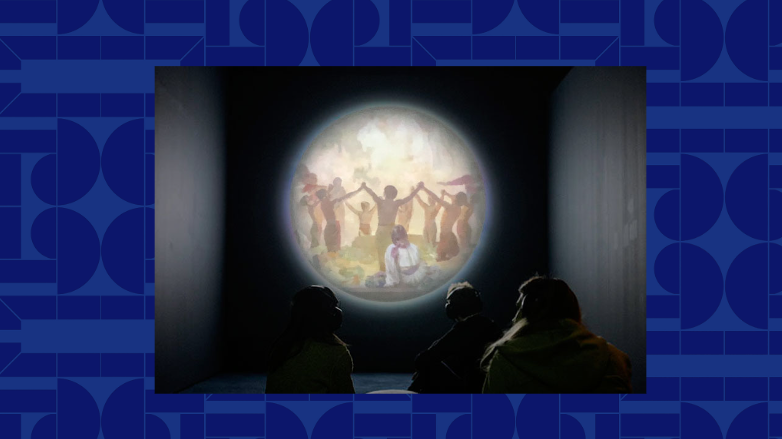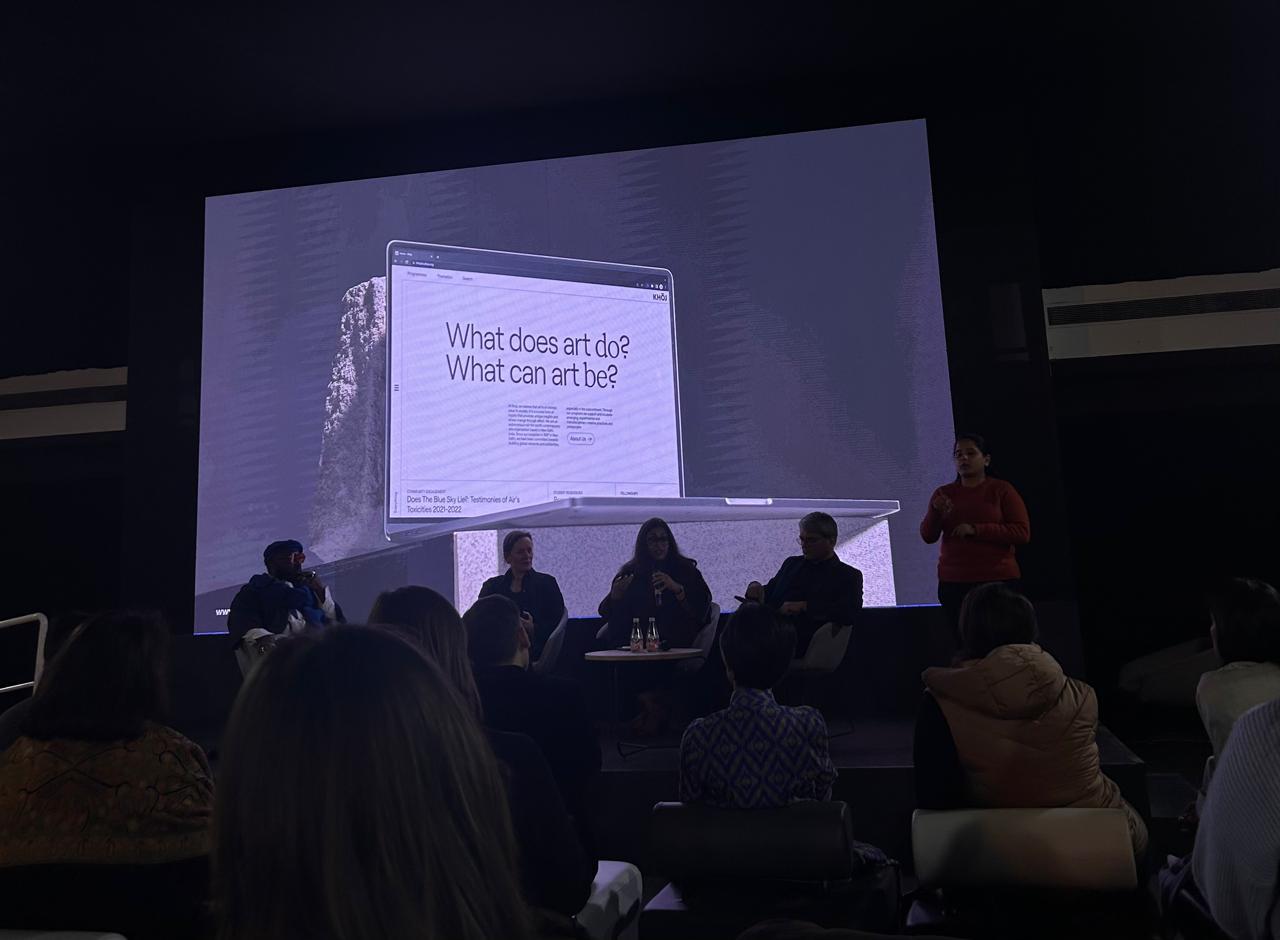Building Solidarities: Transformation through Art
During a panel titled Art: An Agent of Change, organised by Priya Chauhan as part of the India Art Fair 2024, what reverberates and becomes a refrain is “What can art do and what can art be?” The panellists included Pooja Sood, the Director of Khoj; Mónica Bello, Head of Arts at CERN, Geneva; and Dr Bonaventure Soh Bejeng Ndikung, Director and Chief Curator at Haus der Kulturen der Welt, Berlin. The panel was moderated by Shuddhabrata Sengupta, artist and curator with Raqs Media Collective, who began the discussion with a quote from Octavia Butler’s Parable of the Sower (1993)—“All that you touch, You Change. All that you Change, Changes you. The only lasting truth is Change.” Exploring this idea of ‘change’ from different vantage points, the speakers drew on the connection between the role of art as an active tool for change and the fundamental concept of constant transformation at both micro and macro levels.
One of the binding threads of this panel was the intersection of art and science. Decades of work by the panellists developed into projects that have looked into the relationship between artists, scientists and theorists to foster a culture of holistic understanding of change and transformation. Mónica Bello, who has been facilitating innovative integrated projects at CERN, Geneva, presented two artists’ works at the laboratory, where the role of imagination as well as conversation is at the centre. Delving into the idea of comprehending form itself through deep knowledge that is beyond mere cognition, she looks at Suzanne Treister’s Holographic Universe Theory of Art History (2018), developed during her residency at CERN, Geneva. Treister worked together with scientists to develop a hypothesis that used watercolour techniques and projected images from pre-historic to contemporary art, reflecting on the activity of the Large Hadron Collider as it accelerates particles at an ever-increasing rate. Bello juxtaposed Treister’s practice with Patricia Dominguez’s paintings, which understand cosmologies through shared connections between species and cultures by drawing from the cues in nature.

Suzanne Treister, Holographic Universe Theory of Art History (2018), CERN, Art: An Agent of Change, India Art Fair, 2024.
Reflecting on interconnections generated through imagination where art plays a pivotal role, Sengupta recalled Pooja Sood’s interview about Khoj, where she inquired what art can be and what it can do, as well as its potential in creating discourse on engagement with communities. Sood then delved into transforming the space through art and science, art and gaming, and other such collaborative practices that bring together practitioners from diverse backgrounds. The question that becomes urgent for Sood is: How can institutions act as agents that foster creative thinking and build community-driven spaces for artists where experimentation can happen?
Going back to the initial days of the inception of Khoj in 2002, Sood recounted a project by Rohini Devasher from the Khirkee Ki Khoj community art programme (2005). The artist worked with a friend to enter a largely male-dominated area as new inhabitants who were to make a place for themselves. A decade ago, the Khirkee village saw a huge influx of migrants from countries like Congo, Nigeria, Nepal, Somalia and Afghanistan. As a response to an incident where two Ugandan women were accosted by an MLA, artist Swati Janu initiated a project called Coriolis Effect (2016), where she set up a small phone recharge shop and every time she recharged someone’s phone, she would put African music on Bhojpuri migrant labourers’ phones and vice versa. This intrigued the users and, over the year, people who would never converse with each other began to do so. An extension to this approach was developed in the form of Khirkee Voice, a bilingual newspaper that provides a space for local stories. A Somalian refugee, as Sood recalled, collaborated with Khoj by working with designers and curators to create a graphic novel on what it means to be a refugee.
From the perspective of scientific inquiries, Sood looked at projects on climate change, especially on how we breathe and what constitutes air pollution. Zuleikha Chaudhari developed a performative project with Khoj on the farmers’ movement and the politics around stubble burning, titled In the Matter Re: Rights of Nature (2023). These interventions are enabled through an informed institutional practice that allows the artists not only to create works of art but also to create for change. Responding to Sood, Sengupta talked about the conversations that are fostered at Khoj through their ongoing exhibition, 28° North and Parallel Weathers. Drawing from the conversation between a young Afghan woman and her Indian friend on rivers in India and Nigeria at the show, he pointed towards the possibilities of imagination that build solidarities based on dialogue and epistemology that in turn make us “citizens of the world.”
In the Matter Re: Rights of Nature (2023), Khoj International Artists’ Association, Art: An Agent of Change, India Art Fair, 2024.
Sengupta posited questions around care and healing through art in times of crises to Dr Bonaventure, whose work at the SAVVY Contemporary in Berlin enabled an understanding of world cultures and thinking about what it means to transform the world. Bonaventure, who has also trained as a biotechnologist, sees change as a transformative process which he relates to thermodynamics. Drawing parallels to the idea of energy as transforming from one stage into the other, he proposed art as a catalyst for transformation, pointing out that many institutions have been invested in transforming the existing ethos, reacting to a “friction” that is generated in situations of crises such as the pandemic and socio-political conflicts.
His first example of such provocation was the SAVVY Contemporary in Berlin, which emerged at a time when Germany had to deal with its identity as a migrant society. The presence of multi-ethnicity was a reminder to authorities that a monochromatic notion of culture, as Bonaventure mentioned, is short-lived and Germany has always been in touch with the rest of the world. Bonaventure also talked about a journal called The Sun of Cameroon at the beginning of the twentieth century in Germany and the intellectual work produced by it, disproving any notion of a monolithic space.
Another project that Bonaventure mentioned was the Bamako Encounters—African Biennale of Photography, which he organised in 2019–22 in Mali. The festival was presented during a moment of transition when the military regime took over. His conversation with the president, Ibrahim Boubacar Keita, questioned the importance of investing in culture in times of distress and war. The project, for Bonaventure, became a way to bring together artists from Brazil, India, Cameroon and South Africa to create cultural solidarities that were transformative in themselves for the individuals, by going beyond post-colonial and post-modern frameworks.
Art: An Agent of Change, ART ACROSS Talk Series, India Art Fair, 2024. Courtesy: India Art Fair
Bonaventure’s focus on building world cultures led him to work on the SAVVY quarters. During the talk, he discussed a project in Cameroon where this took the form of a library. Bonaventure pointed out that every street in Cameroon has ten clubs, and by applying that model to libraries, they collected six thousand books. Bonaventure recounts working with a local who used to serve stones to people that were collected from Mount Cameroon’s volcanic region of black sand. Observing that this tradition of using stones for scrubbing feet and grinding condiments has faded, the question now became about how one can preserve embodied cultures and knowledge. He called attention to looking towards immediate change that can be brought about by thinking through diverse viewpoints enabled through international collaborations.
On knowledge coming from different cultures, Shuddhabrata Sengupta responded to Bonaventure’s propositions by mentioning Anton Wilhelm Amo’s treatise on philosophical sciences, where he proposes that reasoning is not specific to one culture. Sengupta also brought up the Dabistan-e-Mazahib that came up in eighteenth-century Patna, which pondered over the transcendental idea of what constitutes and comprises the world. He highlighted the different forms of reclamation of spaces occurring in all three panellists’s examples, where existing paradigms are reconfigured. As a concluding remark, Sengupta asked the panellists about the transformative process they have experienced for themselves when they deal with art.
For Sood, art became a medium to diversify her worldview, through which she acted as the enabler of art practices that delved deep into the integration of different fields, fostering a sense of community. Bello shared her anxiety around the power and agency of art but simultaneously believes that art is sobriety, where process and conversation are significant. As for Bonaventure, art challenges and questions the ground we stand on, as well as the space and time we inhabit. It questions gravity and even our notions and assumptions such as those of democracy, freedom of speech and activism. He shared an example of a project based on Walter Rodney’s How Europe Underdeveloped Africa (1972), where artists were invited to understand and produce work that looked at culture and agriculture in Cameroon, Kenya, Trinidad and Tobago that helped question notions of development and underdevelopment. Thus, art acts as a catalyst that invokes speculation and engagement.
Art: An Agent of Change, ART ACROSS Talk Series, India Art Fair, 2024. Courtesy: India Art Fair.
As an audience member, Sabih Ahmed posed a question around the agency of artists in present times, when there is much discussion and distress around institutionality and forms of censorship, to which another audience member added to regarding an international coalition to push forward the role of culture in times of conflict. Bello stated that art is universal and fundamental by nature, and that how institutions choose to work with it is what we need to question. Bonaventure added that the agency of the artist is crucial, but we need to think about agency for art itself, which needs to be given space for it to work and expand. He advised against according radicality to things in an instant and proposed the need to rethink with a wider perspective, seeing the full spectrum to form discourses and opinions rather than flowing into the river of disinformation and polarisations. Sood further pointed out that the way forward is to keep building microsolidarities and community-driven engagement by lending support to artists to produce art and express themselves. Sengupta ended by aptly pointing out that art is an agent of change as well as of power and it matters in what context or for what purpose it is being produced. Regimes and rulers also solicit the agency of artists. We need to look at not only resistance but also acts of complicity with power, which sometimes result in violence, as Sengupta mentions.

“What does Art Do?, What can Art be?”, Website Homepage, Khoj International Artists’ Association, Art: An Agent of Change, India Art Fair, 2024. Image Credit: Saloni Jaiwal.
Art as an agent of change has been active throughout history. It can be an act of resistance and reclamation, but also of propaganda. Change is itself a field that needs reconsideration in the current times of digitised citizenship. The panel opened up some poignant conversations around art acting as a tool for a rather ‘transformative’ change that works from the base principles of understanding nature and cultures. Artists, institutions and enablers today stand at the intersection of global geopolitics, multidisciplinarity and inter-cultural landscapes that can foster dialogue to promote responsibilities of care for communities and a sense of freedom for individuals.
To learn more about this year’s edition of the India Art Fair, read Mallika Visvanathan’s piece on the talk Curators’ Roundtable: Criticality in the Contemporary and Shankar Tripathi’s review of Zahra Yazdani’s show Scripted Selves: Sutures of Signs and Symbols at Latitude 28.




